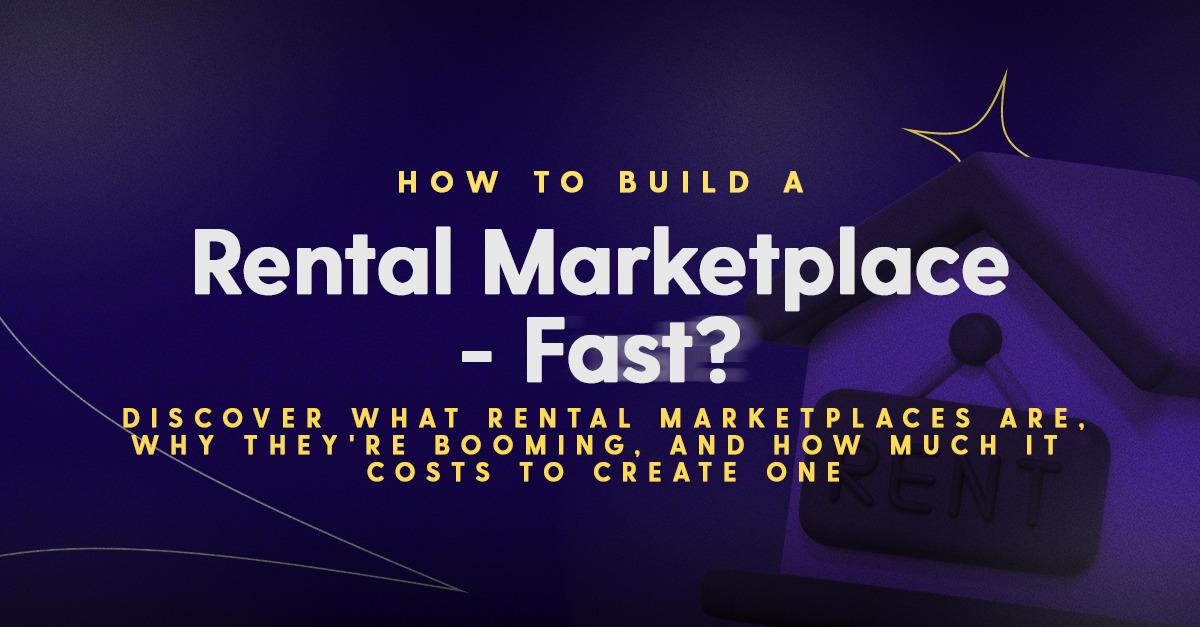How do you build a rental marketplace like Airbnb, Turo or Fat Llama?
Building a successful rental marketplace requires effective execution across a number of different disciplines from marketing to software development and user experience.
In this article, we will cover the steps that we have used to build more than one hundred successful rental marketplace businesses from scratch.
First off, let’s take a look at what actually is a rental marketplace.
What is a rental marketplace?
A rental marketplace is a type of online marketplace (also known as a multi-vendor or peer to peer marketplace) that connects individuals or companies who have property that they wish to rent out temporarily, to consumers who want to use this property without the need for long term ownership.
The most famous example of a rental marketplace is Airbnb which connects property owners (providers) with people in need of short term accommodation (renters).
Since Airbnb, rental marketplaces have become increasingly popular, with marketplace such as Turo offering short term car rentals through to Fat Llama where you can rent just about anything from drones and cameras to party equipment and even pet goats.
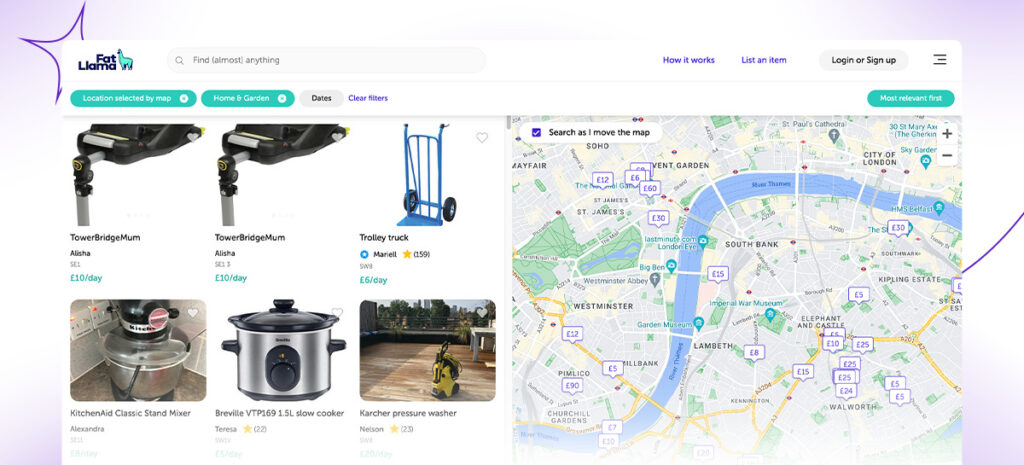
Why are rental marketplaces so popular?
Rental marketplaces are increasingly seen as a better alternative to traditional single sided, inventory-based business models for several reasons.
1. Increase in environmental awareness
Rental marketplaces are considered to have a positive impact on the environment. This is through a reduction in the total resources required for production and the minimizing of waste. For example, clothing rental marketplaces such as Nuuly and Pickle help to keep fashion and other items in circulation longer. Clothing rental sites are a one way to help reduce the emissions produced by the fashion industry.
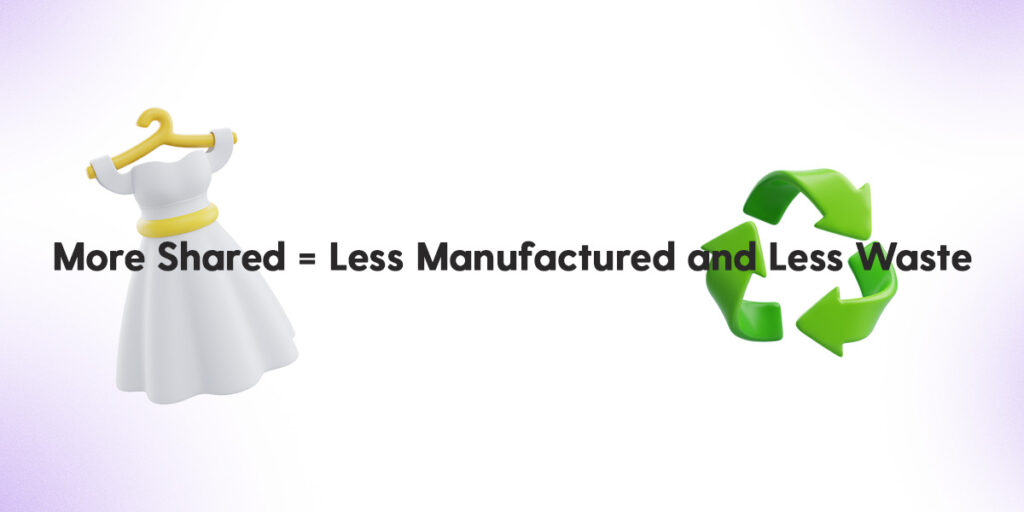
2. Consumers want to save money
Consumers don’t want to waste money on short-lived whims. For example, why would you buy a tent that you are only going to use it once at a music festival?
Rental marketplaces allow consumers to access just about anything. By renting, consumers only pay for the time that they actually need the items. This allows consumers to try new things without needing to make a big financial commitment.
In addition, peer to peer rental marketplaces can afford to charge a much lower fee on transactions compared to traditional inventory based models. This is because they have much lower overheads. This keeps the costs down and allows consumers to use their money how they want.
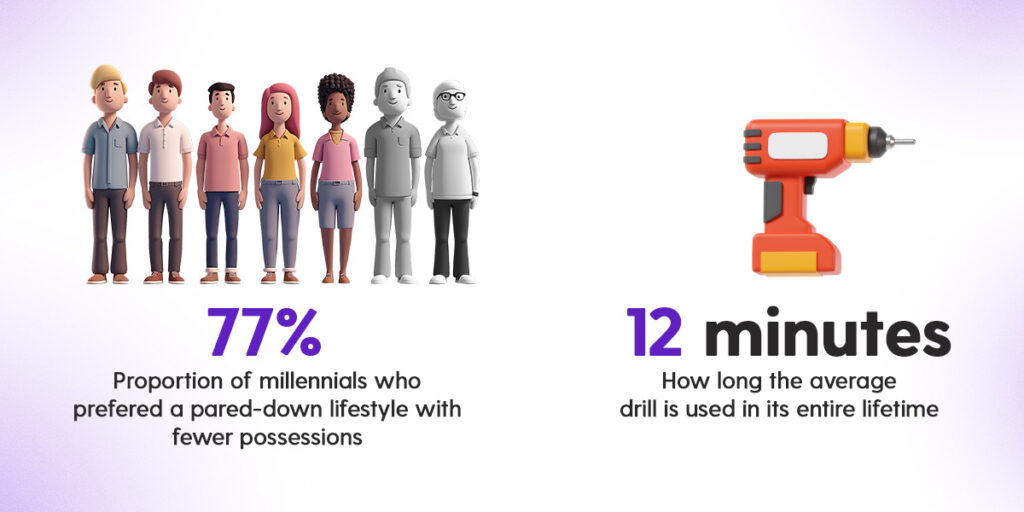
3. Rise of the middle class
For the first time in human history the middle class represents the majority of the global population. Whilst the middle class are not “rich”, rental marketplaces allow them an onramp to greater economic participation.
Rental marketplaces reshaping all middle class age groups. Even in retirement more and more people use renal marketplaces to generate extra income and stay engaged in their local communities. Platforms like GoGoGrandparent are designed to meet such needs.
4. Regulators leaning in, especially in major cities
Regulators are creating policies designed to be favourable towards rental marketplaces. For example, in 2018, Denmark became the first country to enable Airbnb hosts to report income directly to tax authorities. Meanwhile, many other cities are developing rental marketplaces for transportation designed to meet the needs of all residents.
How to build a rental marketplace
In this section we cover the steps to build a successful rental marketplace. These include:
- Find an idea for a rental marketplace
- Validate your idea
- Choose your tech stack
- Choose a business model to start
- Build and launch your MVP
- Onboard your early adopters
- Learn and grow
Please note. A step by step guide is only useful as a framework on how to build a rental marketplace. The ultimate success of your marketplace is down to your own determination and commitment to learn and grow.
Step 1. Find an idea for a rental marketplace
For a rental marketplace business to be successful it must solve a real world problem for both property owners (providers) and renters. For instance, the rental marketplace Airbnb was originally designed to solve the financial strain felt by property owners stuck with vacant or underused spaces. At the same time, it emerged that there were not enough hotel rooms for short term travellers. In response, Airbnb developed a platform for property owners to rent their under-utilized space to travellers struggling to secure short term accommodation.
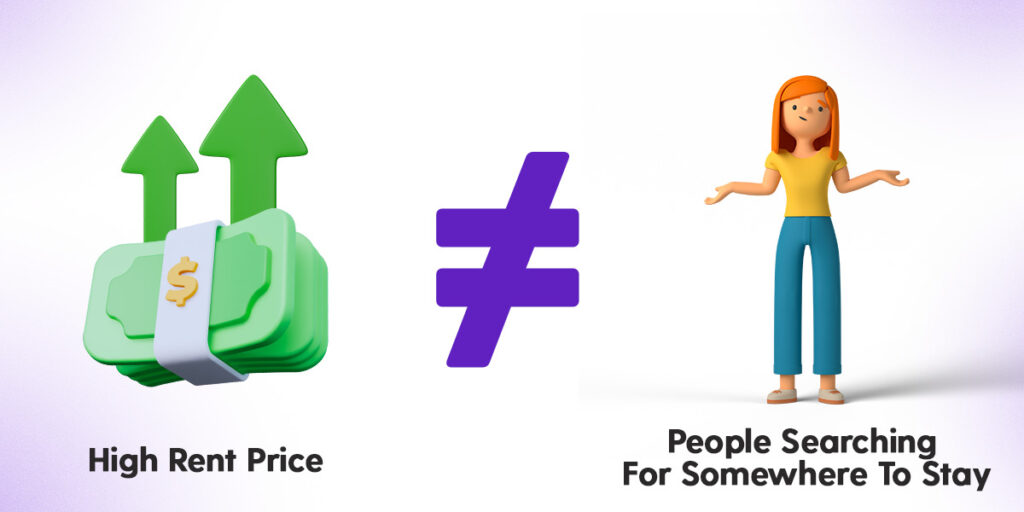
In order to find an idea for a rental marketplace, you could consider ideas for a niche marketplace or passionate and / or underserved communities. The key thing to do is to focus hard on finding a problem that can be solved with rental property. This could be by targeting demographics who are looking for short term use of property without ownership. For instance, students or travellers not looking to make long term financial commitments. You could also consider specific sectors where equipment and property is expensive and/or infrequently used. For instance, outdoor recreation, event planning or construction.
Based on our experience, creating a rental marketplace that solves a problem for a specific audience is always worth testing. However, it is important to find an idea that resonates with your personal passions. This is pivotal because the journey of building your marketplace will span several years, making it essential to engage in a field that sustains your enthusiasm over the long term.
To learn more, read how to come up with a great idea for an online marketplace.
Step 2. Validate your idea
Once you have an idea, the next step is to validate that there is a market for your idea. You should do this before investing too much time or money in the development of your marketplace.
Idea validation essentially involves finding target users and gathering evidence that proves there is genuine demand for your marketplace. There are five popular steps that founders usually take to validate their idea. These are:
- Test any risky assumptions that you’re making about your market
- Assess your market size and share
- Research search volumes for related keywords
- Conduct customer validation interviews
- Build the first version of your marketplace
To test out your idea, you must find real potential customers. You can find these potential users either online or offline. For example, in Facebook groups or physical meetups.
For more information on how to validate your marketplace idea, read our article, how to validate your marketplace business idea.
Step 3. Choose your tech stack
Okay – so you’ve got an idea to solve a problem for a target audience. You have validated that there is a genuine demand for your product. Next, you need to choose a technology stack or “tech stack” that you are going to use to build your rental marketplace. Essentially you have two choices: use a marketplace technology or build from scratch.
Note, you should absolutely NOT use a traditional ecommerce platform like Shopify or Webflow. This is because traditional ecommerce platforms only support single sided ecommerce stores. They have not been built to support multi-vendor, peer to peer marketplaces. Whilst it is true that you can purchase multi-vendor plugins to these solutions, these plugins are heavily limited and will not allow you to build a sustainable marketplace.
Some key things to consider when choosing a tech stack include initial time to market, flexibility, cost of iteration, performance and the cost of hosting. Let’s break down why each of these are important.
Time to market
According to Michael Seibel, managing director of Y Combinator, the primary goal of the startup is to launch fast, learn from customer feedback and iterate quickly. Therefore, you should choose a technology stack that can help you launch your rental marketplace fast.
Flexibility
Once live, you need to iterate fast. This means that you need to choose a technology stack that gives you complete flexibility to customize all aspects of your marketplace. There is no point getting stuck in your tracks after 3 to 6 months of iteration because your technology stack doesn’t permit you to make low level adjustments to the code that powers your marketplace.
Cost of iteration
You should choose a tech stack that can be quickly iterated on without needing to hire expensive, senior engineering talent. This can be challenging if you don’t know how to code however, there are plenty of no code and hybrid no code platforms that you can learn in order to build marketplace technology 10x faster than coding.
Performance
Most of your marketplace’s performance is contained in the backend, application server and database structure. To ensure that your marketplace performs well, make sure you design your marketplace database structure well and choose a high performance programming language such as Google Go.
Cost of hosting
Once your marketplace is live, it needs to be hosted somewhere. Most people will host their marketplaces using Amazon Web Services (AWS), Google Cloud Platform (GCP) or Microsoft Azure. Although it’s hard to keep the cost of your hosting down, by choosing an efficient backend technology and structuring your database correctly, this will help you to keep the cost of your hosting down in the long term.
Step 4. Choose your marketplace business model
There are eight commonly used marketplace business models. These are:
- Commission model
- Subscription revenue model
- Listing fee revenue model
- Lead fee model
- Freemium model
- Ads and featured listings model
- Data licencing model
- Mixed revenue model
Since the commission model is the most popular business model for rental marketplaces, we will focus here on that model. For a more detailed review of the different types of marketplace business model read our article on the top marketplace business models.
In the commission model the rental marketplace platform deducts a percentage or fixed rate commission (also called the take rate, or rakes) whenever a transaction takes place on the marketplace. An example of this is shown in the diagram below.
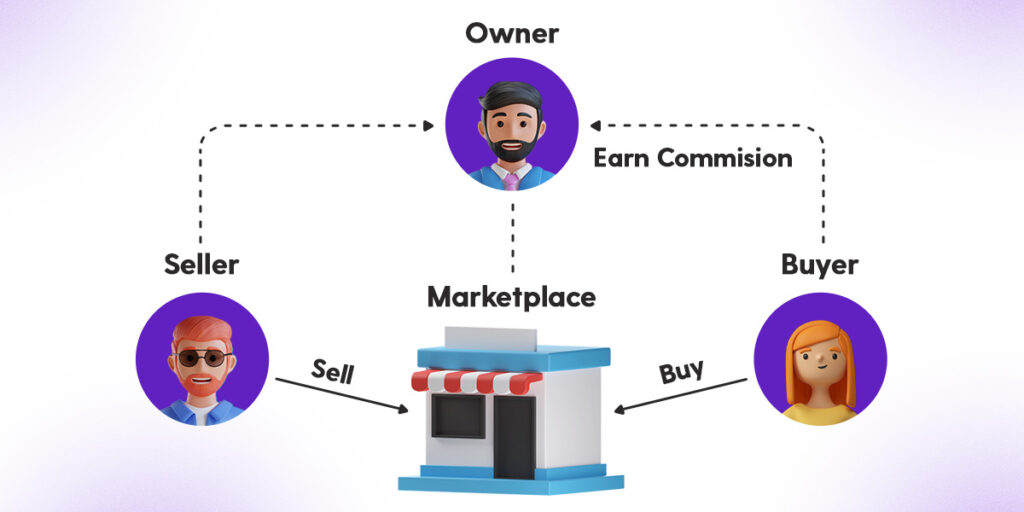
This model is so popular since neither the provider or the renter needs to pay in order to sign up to the platform. This can help to drive the initial user adoption.
Who and what to charge?
When implementing the commission model you need to decide:
- Who you are going to charge the commission fee to
- How much commission you’re going to charge to that person.
Note that the commission fee is also referred to as the take rate, the rake or transaction fee.
Who to charge
The commission fee can be charged to either the provider, the renter or both. But how do you decide who to charge? Well, marketplace investor Bill Gurley gives us a clue. He says:
Bill Gurley, Venture Capitalist
High rakes (or commission) are a form of friction. Therefore, you should charge the commission fee on the side of the marketplace where you are least constrained. For example, if you are most constrained on the provider side, then charge the commission on the renter side and vice versa.
How much to charge
There is no one pricing strategy that works for all rental marketplaces. In fact, the amount of commission that you charge is dependent on the market that you’re working in. This is because all markets have different levels of competition, demand and supply differentiation, marginal costs, transaction size and volume and network effects.
Let’s break down each of these factors now.
Levels of competition
If your rental marketplace operates in a highly competitive sector such as car sharing, this can make it difficult to charge high commissions. This is because high competition forces amount of commission that marketplaces can take lower.
Conversely in a marketplace where there are fewer alternatives to using the marketplace, Marketplaces have more flexibility to set higher transaction fees without the risk of losing customers.
Demand and supply differentiation
Rental marketplaces will often charge providers and renters different amounts based on how much they transact within a given period. This can help incentivize both sides of the marketplace to transact more frequently. For instance, Airbnb offers a discount for travellers booking monthly stays and rewards super hosts with other discounts and rewards.
Marginal costs
To explain how marginal costs impact the commission rate, let’s consider a rental marketplace for vacation homes.
In this example, marginal costs include expenses like cleaning fees and maintenance. These costs directly affect how much hosts earn per booking. For instance, if a host charges $200 per night for their property and incurs $50 in marginal costs for each booking, they make a profit of $150 per night. However, if the marketplace charges a 20% commission, the host’s profit decreases to $120 per night.
Here, hosts assess whether the commission rate allows them to maintain profitability given their marginal costs. If the commission rate exceeds a certain threshold relative to their marginal costs, hosts may reconsider their participation in the marketplace or adjust their pricing strategies accordingly to ensure financial viability.
Network effects
Marketplace network effects occur when the value that a user is able to derive from a platform increases with the number of users, both service providers and customers.
The classic example of how network effects create value is the telephone. Initially, when not many people owned a telephone, there was very few people to call. As such, the value of the telephone was very limited. As more people acquired telephones, the number of potential people to call increased and the value of each individual telephone increases exponentially. As a marketplace operator, this means that the larger your network effect, the larger commission you can charge.
The value provided by your marketplace
Lastly, think about how much value your marketplace provides. Are you just connecting providers and renters or, are you offering any additional tools and services. For example, do you offer insurance or guarantees to protect your customers? Do you offer features that cater specifically towards for premium providers or renters? Tools to help promote property listings that other sites do not offer?
The higher the perceived value of your marketplace, the charge higher commissions you can charge. However, notice that just because you can charge higher commissions this might not be the best strategy.
Step 5. Build and launch your marketplace MVP
At this stage you have found a problem that is being experienced by two sets of people (providers and renters).
You’ve validated that you can solve this problem by connecting up providers and renters using an online rental marketplace.
You’ve chosen a tech stack to build your marketplace on and you’ve identified a business model to start with.
However, even with all of this preparation, it is very difficult to know how people will react when you put a product in front of them. For example, will your users find that your marketplace is easy to onboard onto? Will buyers immediately try and convince service providers to transact outside of your marketplace? Or will your marketplace prove valuable enough to retain users?
The best way to get answers to these questions is to build a minimum viable product or marketplace MVP that will allow you to test out this problem.
The goal of this stage of your marketplace is to build and launch your marketplace MVP as quickly as possible and to get it into the hands of real users. This will allow you to learn if your rental marketplace meets your users needs. It will also allow you to start earning some revenue.
How to build your rental marketplace MVP
A rental marketplace MVP should include only the core functionality that makes users love using your marketplace and nothing more.
The best advice for founders looking to build a rental marketplace is to launch quickly and iterate. Your mindset needs to be that the marketplace MVP is the best possible way to learn about your users. Therefore, to be successful you absolutely must launch fast, listen to customer feedback and iterate.
In spite of the need to launch fast, the majority of marketplace founders never get their MVP live.
In contrast, the successful rental marketplaces e.g. Airbnb, Turno and Fat Llama all launched their marketplace MVP in just weeks. This is not because the founder of these companies were blessed with extremely talented coders. Rather they understood the importance of launching their MVP fast and so went to market only with the bare minimum features.
To build your marketplace MVP you essentially have two options: build your marketplace from scratch or use specialist marketplace technology.
Building a marketplace MVP from scratch can be incredibly complex, expensive and time consuming. Therefore, if you want to build and launch a marketplace using custom code, we advise you to drastically cut the scope of your marketplace. Set yourself a deadline to launch for say three weeks time, then cut the scope to what you can actually get live within three weeks. Then, if you find yourself falling behind, cut the scope and make sure that you launch in three weeks!
As an alternative to coding from scratch, many marketplace founders choose to use marketplace technologies. These platforms allow you to launch a more feature rich MVP fast. The challenge with marketplace technologies is that although they are fast to launch, they are extremely limited and impossible to customize beyond a certain point. As such they are only appropriate for prototype or MVP development.
Dittofi’s hybrid no code platform solves this problem by combining the best of code, no code and marketplace technology into a single visual development interface. This means that, with Dittofi it is fast way to build and launch a feature rich, fully customizable rental marketplace.
To build a rental marketplace using Dittofi’s hybrid no code marketplace builder, you can follow the steps set out below.
1. Start by installing our rental marketplace template
Dittofi comes with a suite of feature rich rental marketplace templates. Each template can be installed into Dittofi’s visual development studio. You can then customize the template from inside Dittofi’s visual development studio, either by accessing the code directly or by using the visual development studio.
For a full list of what is included, see how to build a rental marketplace with Dittofi.
2. Customize your marketplace visually
After you’ve installed the marketplace, the next step is to customize the general marketplace aesthetics and user experience. This includes making the following changes:
- Adding your colour palettes and corporate logo
- Updating the copywriting on the landing pages
- Changing images
- Updating the onboarding workflow
- Configuring your marketplace business model
You should NOT change too much at this stage. Remember your primary goal is to launch your marketplace MVP and go out there and find users.
3. Launch your marketplace MVP on Dittofi
The final step is to attach a custom domain to your marketplace and go live. The link below shows you a complete step by step guide on how to build a rental marketplace for free using Dittofi.
For more information, read our complete guide on how to build a rental marketplace for free using Dittofi.
Now that your rental marketplace is live, it is time to onboard your early adopters.
Step 6. Onboarding your early adopters
Now that you have your rental marketplace, it’s time to onboard your early adopters.
For rental marketplaces, this can be especially challenging since, without providers renting their property there is little incentive for renters to join the site. Meanwhile without renters, property owners will not be interested to list their property on an empty marketplace. This is known as the marketplace chicken and egg problem.
To solve this problem, you need to pick one side, either the provider or renters and convince that side to sign up first. The rule of thumb is to start with the hardest side first. This means that if it is hardest side are renters, start by convincing renters to list their properties. Alternatively, if it is harder to find property owners, start there.
In July 2019, James Currier, five time marketplace founder, gave us 19 tactics to solve the chicken and egg problem. These are shown below.
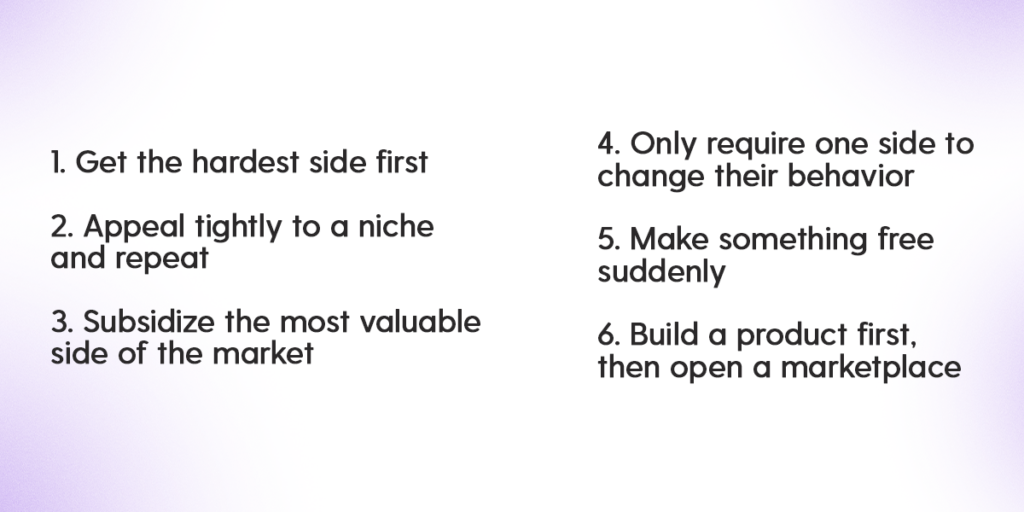
Where to find early adopters
Think back to when you were in your idea validation stage. At this point you spoke to potential users of your marketplace. This allowed you to prove that there was a genuine demand for a marketplace like yours. Now you have your marketplace MVP, go back to those same people and show them what you’ve developed. Your goal is to have developed something that excites people to sign up and (depending on your business model) pay to join.
Your focus will initially be on onboarding one side of the marketplace at a time. After you have a sufficient number of one side, start searching for the next side.
Oftentimes marketplace creators will fill one side of the marketplace themselves first. This has been done by lots of successful marketplace founders such as Brian Chesky, one of the founders of Airbnb. As documented in Airbnb’s legendary startup story, this approach helped the founding team learn what features were needed to improve their marketplace.
Remember, marketplaces don’t magically take off. You have to work hard to manually recruit your customers.This can be uncomfortable at times. As such, many founders put this step off by finding unimportant things to work on such as refining their marketplace MVP. You therefore really need to internalise that the success of your marketplace depends on your own ability to recruit users, listen to their feedback and continually adjust your product.
Step 7. Learn and grow
Now that you have recruited your marketplace early adopters, the next step is to watch closely how your marketplace users behave inside of your product. Do they get stuck onboarding? Are they asking for new features? Are your rates too high? How can you continue to differentiate yourself from other competitive alternatives?
At this stage of your marketplace journey it’s important to be responsive to customer feedback. This means that you will need to make rapid changes to your product. At this point it is the right time to start investing more heavily in your marketplace development.
Please notice. You should absolutely NOT invest in the development of random features. Instead you should let your marketplace users guide the development of your product. To do this, be prepared to build and rebuild the same feature multiple times until it fully solves the customers pain point. This process of build and rebuild has many different names but, most frequently, it is referred to as product iteration.
One of the major challenges that marketplaces encounter during the product iteration stage is that it is time consuming and expensive to make continual product iterations. For instance, imagine that you have to pay for a developer to constantly update features in your marketplace. Each feature could cost $10,000 to get right.
Dittofi has been designed to solve this problem by making it quick and easy to build new features without coding. This is done through the use of advanced visual programming techniques such as dynamic form generation, version control, reusable components, automated devops and so on, that allow professional technology teams to quickly and easily implement new features on fast growing products.
How much does it cost to build a rental marketplace?
There is no fixed price for building a rental marketplace. It depends on a myriad of factors such as, how you build the marketplace, the quality of the engineering team you hire, if you build it yourself and so on. You should also be aware that the process of development is ongoing. Once you start building, you should expect to constantly improve your product in order to stay competitive.
Therefore, the goal should be to budget your development in a sustainable way. This means that you either need revenue to be generated on your marketplace, external investment or to allocate a portion of your monthly income to the development of your marketplace.
In this section we look at the cost of building a rental marketplace in year one and provide a rough budget based on using Dittofi’s no code marketplace solution, compared to the traditional coding.
Building a budget for year one
There are two main costs that you will incur during the first year of building a rental marketplace business: development and marketing.
Cost of rental marketplace development with code
Rental marketplaces are complex to build. Unless you have a lot of experience across product management, software engineering, sales and marketing, you should not expect to be able to build a rental marketplace by yourself.
As a bare minimum, you need a team that has deep product and engineering experience. Furthermore, Having good marketing and sales experience is a major bonus that should not be underestimated.
Product managers should have a deep experience on designing transaction flows, understand the different options on how to take commission payments and handle payouts in a secure and PCI compliant way and much more. Engineers meanwhile should have experience implementing rental marketplaces. This allows them to be forward thinking, so they can design your marketplace in a sustainable way.
Using traditional development methodologies, the process of building your marketplace works as follows:
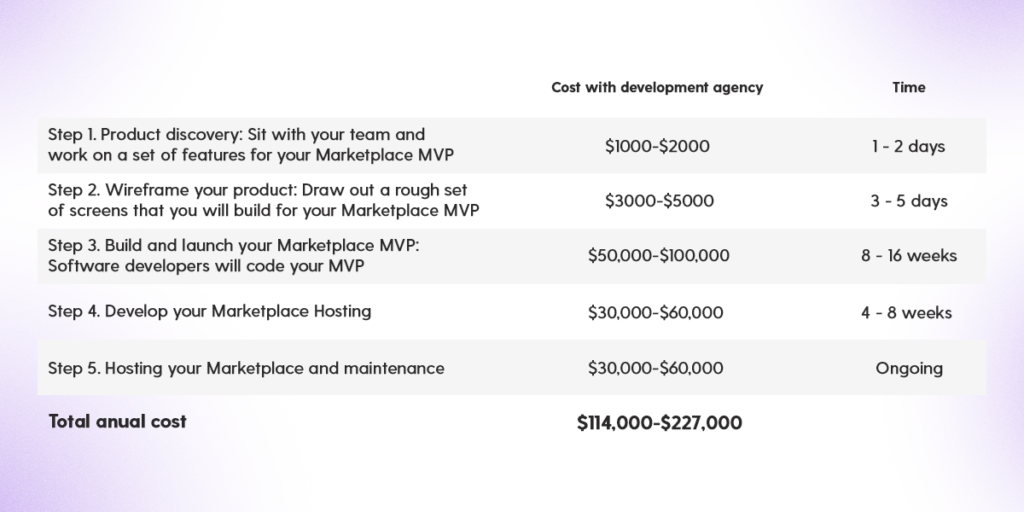
There are risks associated with this approach since it is slow to build and launch your marketplace MVP. Therefore you have no idea how the market will adopt your product when it is live. Furthermore, when you get to iterating on your product it will cost you around $10,000 to make any meaningful iteration to your marketplace.
The approach runs completely against the advice given in the previous section where we discussed how to build your marketplace MVP. The approach is slow and expensive to build your MVP and requires a large upfront investment. In fact you should be spending very little on your marketplace MVP and investing heavily only when you’ve worked out that you’re solving a real world problem for providers and renters.
Cost of rental marketplace development with Dittofi
An alternative approach is to use a marketplace technology such as Dittofi. In this instance you are able to build your marketplace MVP in the following steps.
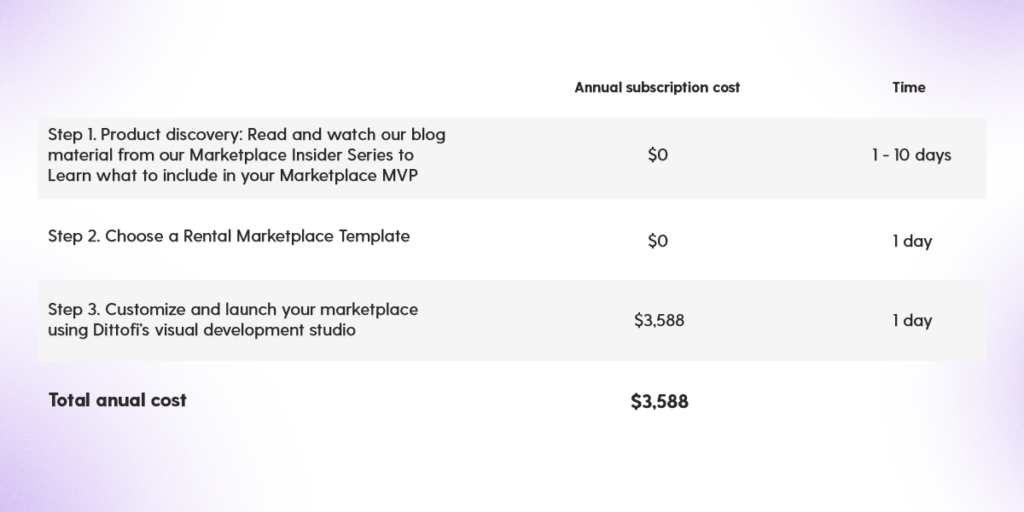
Dittofi is 170% lower price than building with a development agency. Furthermore, it requires no upfront investment and you are only charged when you go live. Lastly, the feature set that you get has been designed with the weight of experience since, Dittofi has developed hundreds of rental marketplaces. Finally, Dittofi allows you to access every line of code for your rental marketplace. Therefore, you also own a modern tech stack that is powered by React and Google Go code. This code is equivalent to the code produced by the very best development teams working. It is simple, secure and efficient and can be deployed in a single click into a fully serverless environment with 99.99999999% uptime guarantee.
Furthermore, once your marketplace MVP is live and you have feedback from your first sets of customers, you can now start to invest in rapid iteration either by using Dittofi’s visual development studio or by exporting the code and handing it off to developers. If you choose to use Dittofi, you can keep your development cost low and move faster than traditional coding.
Cost of marketing your rental marketplace
Building your marketplace MVP and getting early adopters is just phase one. Next, you need to start to acquire more users. To do this, you need to learn how to market your solution to providers and renters. This requires the development of a marketplace marketing strategy where you will consider both paid and unpaid marketing channels. Below is a minimum budget that you should expect to spend in year 1 on marketing. You should allocate this budget monthly and be prepared to switch between different marketing channels based on what works and what doesn’t work.
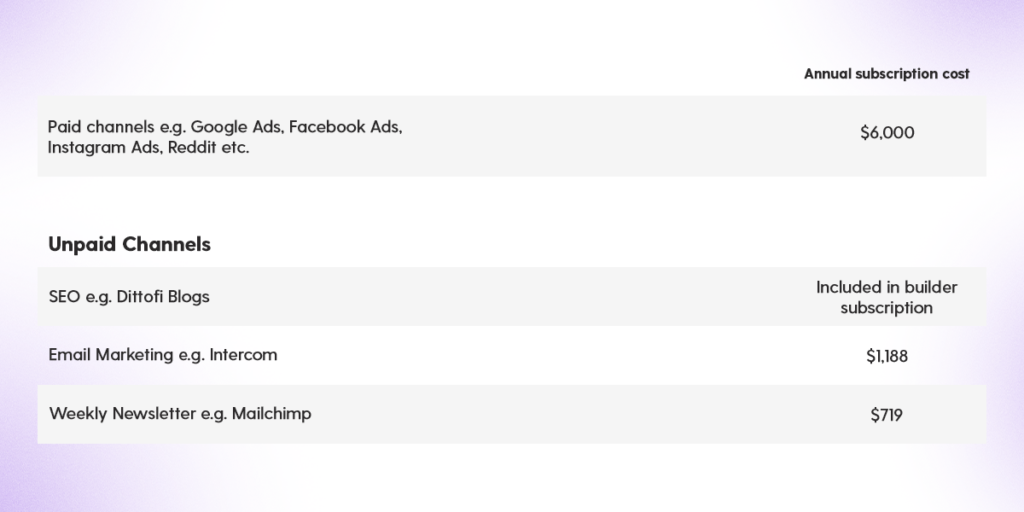
Therefore, you should budget for an additional $7,907 on marketing software. Of course, you will need to put in your own time to make the material.
Final thoughts: Building your rental marketplace business
Building a successful rental marketplace can feel like a large and intimidating process.
But don’t let this stop you.
Building any type of business is a lot of work but it is also incredibly empowering to become self sufficient and not to be dependent on a corporation for your source of revenue.
To build a successful rental marketplace, take it in small steps and be willing to work hard to make it a success.
Remember, good products are rarely built in isolation,. Rather they are built as part of a collaboration between the marketplace operator and their users. So stick to the iterative approach to give yourself the best chance of success. Launch your marketplace MVP early, learn from your users and iterate fast.
If you’re interested to learn more, book a call with one of our marketplace specialists for a free 45 minute consultation.
And… in case we don’t speak, we wish you the best of luck with your marketplace development!
Become a Marketplace Insider
Join our inner circle for exclusive insights, coveted trade secrets, and unparalleled strategies – your journey to marketplace dominance begins here.

